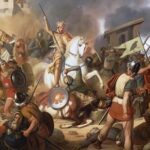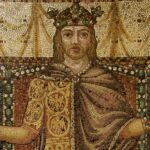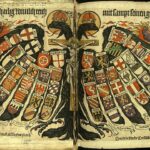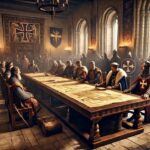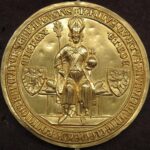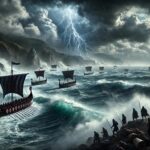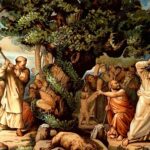
It’s Christmas Day in the year 800. You’re standing inside the old St. Peter’s Basilica in Rome. The air smells of incense. The Pope is placing a golden crown on a tall, broad-shouldered king’s head. The crowd erupts in cheers: “Long live Charles, Augustus, crowned by God!”
You’ve just witnessed the birth of the Carolingian Empire, and the man at the center—Charlemagne—will go down as one of the most influential figures in all of European history.
Charlemagne’s story is more than just swords and crowns. It’s a saga of revival—of literacy, law, faith, and political unity after the chaos of the post-Roman world. Let’s explore how this one man and his dynasty helped shape the Middle Ages—and how his influence still lingers today.
From Frankish King to Emperor of the West
Charlemagne (Charles the Great) was born around 742 CE, the son of Pepin the Short and grandson of Charles Martel. He became king of the Franks in 768, and by 774 he had conquered the Lombards in Italy. But Charlemagne wasn’t just expanding territory—he was building a vision.
In 800 CE, after decades of campaigning, Pope Leo III crowned him Emperor of the Romans. It was a symbolic moment—a nod to the old Roman Empire, revived under a Christian Frankish ruler. It also marked the formal creation of the Carolingian Empire, a multi-ethnic state that stretched from the Atlantic Ocean to central Europe.
Charlemagne’s empire was ambitious—militarily, politically, and spiritually. It wasn’t just about conquest. It was about order, unity, and rebirth.
The Carolingian Renaissance
Charlemagne believed that a strong, godly empire needed an educated people. So he launched what historians now call the Carolingian Renaissance—a revival of learning, art, and religious reform.
- Monasteries became centers of literacy and scholarship.
- Scriptoria copied classical Latin texts, preserving works that would have otherwise been lost.
- Cathedral schools were established to train clergy and administrators.
- The Carolingian minuscule, a clear and legible script, became a standard of writing for centuries.
Charlemagne himself couldn’t write, but he deeply respected learning. He surrounded himself with scholars like Alcuin of York, who helped standardize education and liturgy throughout the empire.
The revival wasn’t just academic—it was spiritual. The empire promoted a unified Christian identity, pushing for proper doctrine, uniform practices, and moral reform among clergy and laity alike.
Government and Daily Rule
Charlemagne ruled through an extensive and surprisingly organized system for its time:
- Missi dominici (“envoys of the lord”) were royal agents sent in pairs—usually a noble and a bishop—to inspect regions, administer justice, and enforce laws.
- A revised legal code, blending Frankish customs with Christian ethics, applied across the realm.
- The empire was divided into counties, each ruled by a count, who managed military, judicial, and administrative tasks.
Despite the size of his realm, Charlemagne insisted on accountability and communication—holding annual assemblies where laws were discussed and decisions made.
Military Campaigns and Expansion
Charlemagne’s empire was built on steel and strategy. He conducted over 50 military campaigns, some defensive, others expansionist:
- Against the Saxons, he waged a long and bloody war, eventually converting them to Christianity.
- He battled Avars in Central Europe and expanded influence into Slavic lands.
- In Spain, he tried (unsuccessfully) to push deeper into Muslim territory.
These wars were often framed as crusades before the Crusades—not just conquest, but conversion.
Yet the cost of this expansion was high. Entire populations were displaced or massacred. The Massacre of Verden (782), in which thousands of Saxon prisoners were executed, remains one of the darkest moments of his reign.
A Vision for Christian Kingship
Charlemagne saw himself as more than just a ruler—he was a protector of Christendom. He referred to his rule as a sacred duty, blending Old Testament kingship with Roman imperial ideals and Frankish warrior culture.
This created a new model for kingship:
- The king as God’s representative on Earth.
- The king as lawgiver and moral example.
- The king as defender of the Church.
This model influenced European monarchies for centuries, from the Holy Roman Emperors to medieval English and French kings.
Decline and Legacy
Charlemagne died in 814 CE and was buried in Aachen, the capital of his empire. His son, Louis the Pious, inherited the throne, but after his death, the empire fractured among his sons.
The Treaty of Verdun (843) divided the empire into three parts—roughly aligning with modern France, Germany, and Italy. This fragmentation weakened Carolingian unity but laid the geographic foundations for later European nations.
Still, Charlemagne’s legacy endured:
- The Holy Roman Empire, founded in 962, traced its legitimacy to him.
- The idea of a unified Christian Europe remained powerful through the Middle Ages.
- His reign inspired later rulers, including Napoleon and even EU leaders invoking unity.
Cultural and Modern Echoes
Charlemagne’s name lives on everywhere—from the Charlemagne Prize awarded to European unifiers, to place names, statues, and cathedrals. His push for literacy and law gave medieval Europe the structure to survive and grow.
Want to see it firsthand? Visit Aachen Cathedral, a UNESCO World Heritage Site, where his throne still sits. Or explore Carolingian manuscripts preserved in libraries across Europe.
Even in pop culture, Charlemagne shows up—from operas and novels to video games. He remains the archetype of the “just ruler” in the West.
Charlemagne and the Carolingian Empire weren’t just a flicker in the darkness after Rome—they were a torch, lighting a path toward a new European identity. His empire may have broken apart, but the ideas he championed—unity, education, faith, and rule of law—are still with us.
To dive deeper, check out related articles:
German History Timeline Overview – A concise chronological guide to major events, from early tribes to reunification and modern Germany.
The Rise of the Franks – Discover how this once-small tribe evolved into a dominant political force in early medieval Germany.
The Holy Roman Empire – Explore the history of the Holy Roman Empire—its origins, emperors, politics, and role in shaping medieval and modern Germany and Europe.
The Saxons and Their Conversion to Christianity – See how religion and conquest collided as Christianity spread through northern Germanic lands.
The Vikings and Their Influence on Germany – Explore the northern impact of Viking raids, trade, and cultural exchange in early medieval German territories.
The Treaty of Verdun and the Division of Charlemagne’s Empire – Explore the 843 AD agreement that created distinct political boundaries and influenced today’s Europe.
